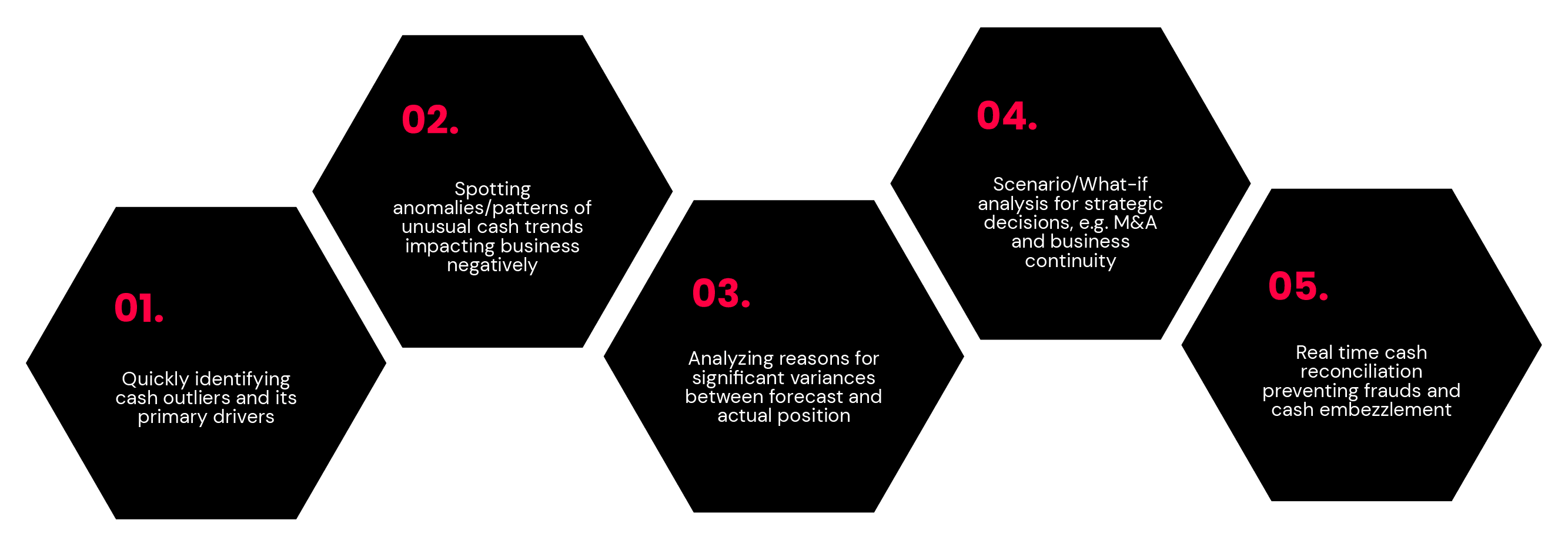As per GTreasury 2021 Cash Forecasting & Visibility Survey Report, the majority of treasurers are seeking global cash positions that can update on a real-time or intraday basis, but many report being stuck with weekly (or less frequent) updates.
Driving real time visibility and control for an agile treasury: Real time cash flow dashboard
As per GTreasury 2021 Cash Forecasting & Visibility Survey Report, the majority of treasurers are seeking global cash positions that can update on a real-time or intraday basis, but many report being stuck with weekly (or less frequent) updates. It becomes pertinent at this point to raise this important question:
As a treasurer, how often do you review your cash account and bank statements?
Does your organization have multiple geographical entities/bank accounts/business functions but no/limited visibility into cash position/forecast insights on a real-time basis?
If yes, it goes without saying that your business would have regularly suffered massive cash crunch(s), delayed supplier payments, misforecasted cash position etc., especially as Covid-19 pandemic eroded market liquidity very rapidly.
So, how were treasuries addressing the need to have real time cash/liquidity data so far?
Earlier, the treasurers widely used inefficient static dashboards/excel spreadsheets to assemble their cash flow positions – stitching together humongous data from multiple sources – nothing more than a garbled cash picture. Offering limited usage in studying historical/current cash trends, these tools were neither capable of advanced analytics nor could identify anomalies or variances on a real time basis. Unmistakably, a labor intensive & error prone process which completely disregarded the value of time-sensitivity of the cash position data.
Covid-19 pandemic finally brought to the forefront the unequivocal need for treasuries to own a
Continuously updated in real-time, User customizable (DIY) cash flow dashboard
An embedded Business Intelligence dashboard displaying your business’ KPI’s related to cash flow, liquidity & working capital – in real time – with data imported from automated, real time cash reporting & forecasting systems – serving as a ‘single version of truth’ for all stakeholders.
Key features
- Built in artificial intelligence of data mining with advanced analytics
- User Customization supports a) multiple charting options b) Data slicing & dicing with custom user defined measures/calculated fields
- DIY capability allows user to derive key business insights and a) create intuitive visualizations b) generate dynamic dashboards with interactive feed and reports
- Cloud native technology: a) advantage of elasticity of cloud b) stateless c) multitenant model and d) quickly redirects traffic during low usage saving on costly downtimes
- Machine-learning driven engine to identify anomalies, patterns, outliers & variances
- 360 degrees’ connectivity and integration with multiple internal/external data sources
- Real time updates and alerts facilitates faster, more accurate decision making
- Eliminates tedious manual error prone processes
Key performance indicators on a cash flow dashboard
Depending upon the nature and size of the business, an organization’s preferred KPI’s on their cash flow dashboard may vary. However, the most significant metrics would still be:
1. Net Consolidated Cash Position – Actual and Forecast:
It allows treasurers to have a headline view of consolidated cash position in a single base currency which can be drilled down further across products, geographies and currencies, both current and forecasts. They can view all the transactions (both inflows and outflows) impacting cash activity during a specific period of time. It also supports segmentation into activities: operating, investing and financing.
Overall, it helps in taking timely corrective measures to stop cash bleeding by:

2. Available Liquidity – Actual and Forecast:
During the pandemic when most of the organizations faced cash crush, having a real time view of available internal liquidity, in the form of cash reserves and working capital became imperative so that external liquidity can be quickly arranged. The real time forecasted position will help in identifying periods that may result in cash deficit uncovered by available sources of credit. Variance analysis between actual and forecast provides timely insights into factors/expenses needed to be controlled. Thus, enables business to maintain optimal liquidity at all times.
3. Working Capital Metrics – Cash Conversion Cycle, Accounts Receivables, Accounts Payables:
Tracking the cash conversion cycle is important for manufacturing companies facing significant delay in receiving payment from its customers which can in turn effect the payment cycle to its suppliers. Diligently monitoring CCC regularly can help in better control and management of company’s overall operations, A/R and A/R and credit control strategy.
4. External Debt, Financial Ratios:
Few of the other important indicators which will help in understanding current financial health better could be gross external debt, working capital limits/credit lines from banks available and utilized, financial ratios, covenant ratios etc. Inbuilt real time alerts and notifications about credit lines fully used, bank loan covenants breached, over leveraged position etc. can be very useful in taking timely corrective actions.
Conclusion
During the pandemic, treasuries having access to such a dashboard, got instant visibility of their consolidated current and projected cash/liquidity. The rapidly weakening market liquidity position made it extremely difficult for businesses to survive and stay afloat in the longer run. The dashboard empowered the treasurers to: quickly collect actionable KPI’s insights and adapt their cash & liquidity management strategy in time, through facilitating quick decision making at CFO/Board level.
It was during these difficult times that the true worth of a cash flow dashboard (which is easy to construct and user friendly) became sufficiently evident.
Thus, availability of real time, accurate cash/liquidity data has in fact become a necessity and not a luxury anymore, for an agile and intelligent treasury.
Other resources

How era-defining technology has enabled treasury transformation
The treasurer’s role has evolved from being operational to a true strategic partner. This change has been aided by technological transformations, which have brought in a new set of insights and expectations into a treasurer’s role.

Re-evaluating treasury – role, skills and priorities in the re-defined CFO’s office
CFO Research (part of Argyle Advisory and Research Services) and Grant Thornton surveyed 631 & 174 CFOs/ senior finance executives respectively, in Feb and May 2020, to gauge the effects of the COVID-19 upheaval.

The treasurer’s role has evolved from being operational to a true strategic partner. This change has been aided by technological transformations, which have brought in a new set of insights and expectations into a treasurer’s role.

CFO Research (part of Argyle Advisory and Research Services) and Grant Thornton surveyed 631 & 174 CFOs/ senior finance executives respectively, in Feb and May 2020, to gauge the effects of the COVID-19 upheaval.